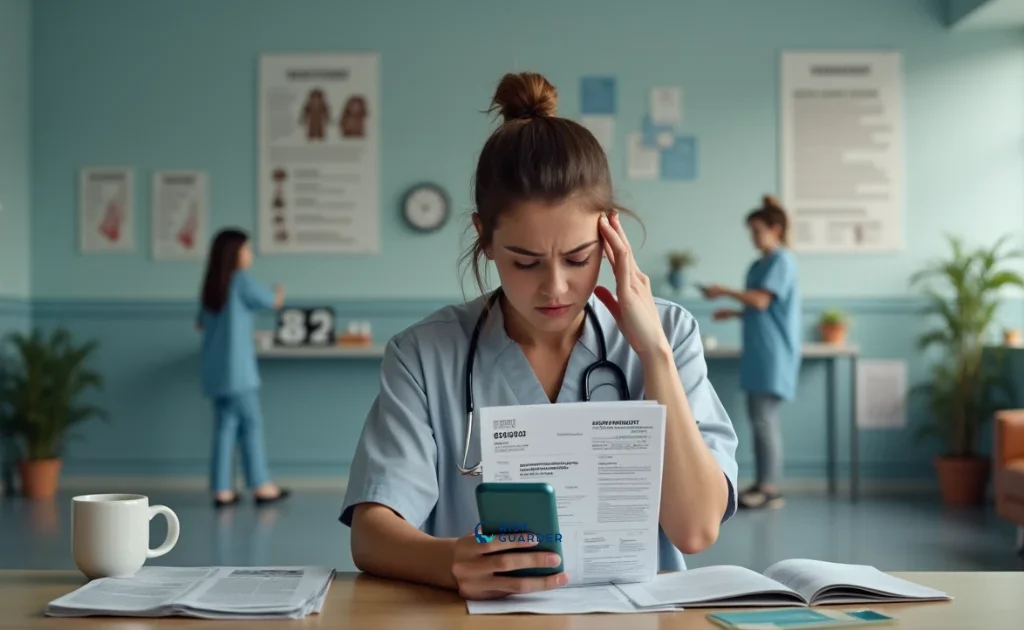Facing Unexpected Medical Needs Without Insurance
Imagine this: you wake up one morning with a sharp pain in your leg after a minor fall, or perhaps you develop a sudden, high fever that keeps you up all night. The urgency to seek medical attention is palpable, but there’s a catch—you don’t have health insurance. The anxiety of needing immediate care without knowing the financial implications can be overwhelming. You’re not alone in this predicament, and understanding the landscape of urgent care costs without insurance can empower you to make informed decisions during such critical moments. This article will guide you through the complexities of urgent care expenses, offering practical solutions and resources to help you navigate these challenging situations with confidence.
What Is Urgent Care Cost Without Insurance ?

Defining Urgent Care Services
Urgent care centers serve as a bridge between primary care physicians and emergency rooms, providing timely medical attention for non-life-threatening conditions. These facilities are designed to handle situations that require immediate care but aren’t severe enough to warrant an ER visit. Here’s what you can typically expect:
- Types of Services Offered
- Treatment for Minor Injuries: Whether it’s a sprained ankle, a minor cut, or a bruise, urgent care centers can provide the necessary treatment to help you recover quickly.
- Management of Illnesses: From the flu and infections to minor burns, these centers can diagnose and treat a variety of common ailments.
- Diagnostic Services: Many urgent care facilities are equipped with X-ray machines, lab testing capabilities, and other diagnostic tools to accurately assess your condition.
Urgent Care vs. Emergency Room
Understanding the difference between urgent care and emergency room services is crucial, especially when you’re weighing costs without insurance.
- Differences in Cost
- Emergency Room (ER): ER visits can be significantly more expensive, often ranging from $1,000 to $3,000 or more, depending on the severity of the condition and the treatments required.
- Urgent Care: In contrast, urgent care visits typically cost between $150 and $500, making them a more affordable option for non-life-threatening issues.
- Situations Best Suited for Each Facility
- Urgent Care: Ideal for ailments like minor fractures, sprains, cuts requiring stitches, and illnesses that need prompt attention but aren’t life-threatening.
- Emergency Room: Reserved for severe conditions such as chest pain, difficulty breathing, severe bleeding, or head injuries where immediate, comprehensive care is necessary.
Factors Influencing Urgent Care Costs Without Insurance

Understanding the Cost Components
When navigating urgent care without insurance, several factors contribute to the overall cost of your visit. Being aware of these components can help you anticipate expenses and explore ways to manage them effectively.
- Base Service Fees
- Typical Range of Costs: The initial consultation fee at an urgent care center can range from $100 to $200. This fee covers the basic evaluation and treatment provided by the healthcare professional.
- Diagnostic Tests and Procedures
- Costs for X-rays, Lab Tests, and Other Diagnostics: Additional services like X-rays can add another $100 to $300 to your bill, while lab tests may cost between $50 and $150. These diagnostics are essential for accurate diagnosis and effective treatment.
- Treatment and Medication Costs
- Fees for Treatments Administered and Prescriptions Provided: Depending on the treatment required, costs can vary. For instance, treating a sprain or fracture might cost between $150 and $400, and prescription medications could range from $20 to $100.
Average Costs of Common Urgent Care Services Without Insurance
| Service | Average Cost (USD) |
|---|---|
| Basic Consultation | $100 – $200 |
| X-Ray | $100 – $300 |
| Blood Tests | $50 – $150 |
| Sprain or Fracture Treatment | $150 – $400 |
| Prescription Medications | $20 – $100 |
Evaluating the Expenses of Urgent Care in Relation to Alternative Medical Services

Urgent Care vs. Emergency Room
When facing a medical issue, choosing between urgent care and the emergency room can significantly impact your expenses and care experience.
Cost Comparison
- ER Visits: Emergency room visits are substantially more expensive, often costing between $1,000 and $3,000 or more, depending on the severity of the condition and the treatments required.
- Urgent Care: Urgent care centers offer a more affordable alternative, with costs averaging between $150 and $500 for most non-life-threatening conditions.
Wait Times and Convenience
- Shorter Wait Times at Urgent Care Centers: Unlike ERs, which can be crowded and involve long wait times, urgent care centers typically see patients on a first-come, first-served basis, leading to quicker access to medical attention.
- Extended Hours Availability: Many urgent care centers operate beyond regular business hours, including evenings and weekends, providing flexibility for patients who need care outside of typical office hours.
Urgent Care vs. Primary Care Physicians
Choosing between urgent care and your primary care physician (PCP) depends on the nature of your medical issue and your immediate needs.
When to Choose Each Option
- Urgent Care: Best suited for immediate, non-life-threatening health issues such as minor injuries, illnesses that require prompt attention, or when your PCP is unavailable.
- Primary Care Physicians: Ideal for ongoing health management, routine check-ups, chronic condition management, and preventive care. PCPs often require appointments and may not be as readily accessible for urgent needs.
Cost Differences
- Primary Care Visits: Without insurance, primary care visits can be less affordable as they may not be designed to handle urgent issues on a walk-in basis. Appointments might range from $100 to $300, similar to urgent care, but without the immediate availability, they might not be practical for urgent needs.
Ways to Reduce Urgent Care Costs Without Insurance
Navigating urgent care expenses without insurance requires strategic planning and resourcefulness. Here are several methods to help you manage and reduce costs effectively.
Utilize Discount Programs and Payment Plans
In-House Discounts
Many urgent care centers recognize the financial strain uninsured patients may face and offer discounts for self-pay individuals. These discounts can significantly reduce your out-of-pocket expenses.
- Negotiated Rates: Some centers provide a sliding scale based on your income, ensuring that services remain affordable.
- Membership Programs: Certain facilities offer membership plans that provide discounted rates for a fixed annual fee, which can be cost-effective if you anticipate frequent visits.
Payment Plans
Flexible payment options can make urgent care expenses more manageable by spreading out the costs over time.
- Monthly Installments: Agreeing to monthly payments can alleviate the burden of a large, one-time bill.
- Deferred Payments: Some centers allow you to receive treatment upfront and pay the bill after receiving your next paycheck or financial support.
Seek Out Community Health Clinics
Community health clinics are invaluable resources for individuals without insurance, offering comprehensive care at reduced costs.
Low-Cost or Sliding Scale Fees
Eligibility for these clinics is often based on your income and financial situation, ensuring that medical care remains accessible regardless of your ability to pay.
- Affordable Services: Clinics may offer services on a sliding scale, meaning the cost decreases as your income decreases.
- Transparent Pricing: Many clinics provide clear, upfront pricing for their services, helping you avoid unexpected expenses.
Available Services
Local health centers generally provide a diverse array of services, such as:
- General Healthcare: Regular examinations, preventive treatments, and ongoing management of long-term illnesses.
- Urgent Care: Immediate treatment for non-life-threatening conditions similar to urgent care centers.
- Specialized Services: Some clinics offer specialized care, such as mental health services, dental care, and women’s health services.
Negotiate Bills and Ask for Cost Estimates
Being proactive about your medical expenses can lead to significant savings. Here’s how you can negotiate bills and obtain accurate cost estimates.
Before Receiving Services
- Request a Detailed Cost Estimate: Contact the urgent care center beforehand to understand the expected costs for the services you might need. This can help you budget and make informed decisions about your care.
- Inquire About Discounts: Ask if the facility offers discounts for self-pay patients or has any ongoing promotions that could reduce your bill.
After Services Rendered
- Review Your Bill: Carefully examine your bill for any discrepancies or unnecessary charges. If you find any errors, don’t hesitate to bring them to the attention of the billing department.
- Negotiate Lower Payments: Contact the billing department to discuss your financial situation. Many providers are willing to reduce the total amount owed or set up a manageable payment plan.
- Seek Financial Assistance: Inquire about any financial assistance programs the center may offer, which can help further reduce your costs.
Insurance Alternatives and Assistance Programs
While navigating urgent care costs without insurance can be daunting, several alternatives and assistance programs can help bridge the gap. Exploring these options can provide you with the necessary coverage and financial support to manage medical expenses effectively.
Short-Term Health Insurance Plans
Short-term health insurance plans offer temporary coverage options that can be particularly useful in unexpected medical situations.
Coverage Details
- Temporary Solutions: These plans provide coverage for a limited period, typically ranging from a few months up to a year, serving as a stopgap measure until you secure more comprehensive insurance.
- Basic Coverage: While not as extensive as standard insurance, short-term plans can cover essential medical services, including urgent care visits.
Cost and Availability
- Affordable Plans: Short-term plans are generally more affordable than traditional insurance, making them an attractive option for those on a tight budget.
- Flexibility: These plans offer flexibility in terms of duration and coverage levels, allowing you to tailor the plan to your specific needs.
Health Savings Accounts (HSAs) and Flexible Spending Accounts (FSAs)
Health Savings Accounts (HSAs) and Flexible Spending Accounts (FSAs) are financial tools designed to help individuals save for medical expenses.
How They Work
- Pre-Tax Contributions: Both HSAs and FSAs allow you to set aside pre-tax dollars to cover eligible medical expenses, reducing your taxable income.
- Accessibility: Funds from these accounts can be used to pay for a wide range of medical services, including urgent care visits.
Benefits for Urgent Care Costs
- Immediate Access to Funds: HSAs and FSAs provide immediate access to funds for urgent care needs, ensuring you can receive the necessary treatment without delay.
- Tax Advantages: Contributions are tax-deductible, and withdrawals for qualified medical expenses are tax-free, providing financial benefits in addition to covering costs.
Government Assistance Programs
Government assistance programs are designed to support individuals who may not have access to affordable healthcare options.
Medicaid Eligibility
- Income-Based Eligibility: Medicaid eligibility varies by state but is generally based on income and family size. If you fall below a certain income threshold, you may qualify for coverage.
- Comprehensive Coverage: Medicaid often covers a wide range of medical services, including urgent care, ensuring that you receive the necessary treatment without exorbitant costs.
Other Local Assistance Programs
In addition to Medicaid, various local programs and non-profit organizations offer financial aid and support for medical expenses.
- Community Resources: Local health departments and community centers may provide resources or referrals to affordable care providers.
- Non-Profit Organizations: Organizations like the HealthWell Foundation and the Patient Advocate Foundation offer assistance to individuals struggling with medical bills.
Real-Life Experiences: Managing Urgent Care Costs Without Insurance
Hearing about others’ experiences can provide valuable insights and practical strategies for managing urgent care costs without insurance. Here are two real-life case studies that illustrate effective approaches to handling unexpected medical expenses.
Personal Stories and Testimonials
Case Study 1: Navigating Costs After a Sports Injury
Scenario: Jane, an avid runner, sprained her ankle during a marathon. With no health insurance, she was worried about the cost of urgent care.
Steps Taken:
- Sought Immediate Care: Jane visited a local urgent care center for initial treatment and an X-ray.
- Negotiated the Bill: After receiving her bill, she contacted the billing department to negotiate a lower rate, explaining her financial situation.
- Utilized Payment Plans: The urgent care center agreed to a monthly payment plan, allowing Jane to spread out the cost over several months.
- Explored Community Clinics: Jane also sought follow-up care at a community clinic, which offered sliding scale fees based on her income.
Outcome: By proactively negotiating and utilizing available resources, Jane managed her urgent care costs without overwhelming debt, allowing her to focus on recovery.
Case Study 2: Dealing with an Unexpected Illness
Scenario: Mark developed a severe case of the flu and needed immediate medical attention. Without insurance, he was concerned about the high costs associated with urgent care.
Steps Taken:
- Obtained a Cost Estimate: Before receiving treatment, Mark contacted the urgent care center to get an estimate of the expected costs.
- Used an HSA: Mark had funds in a Health Savings Account (HSA), which he used to cover the urgent care expenses tax-free.
- Accessed Government Assistance: Mark applied for Medicaid, qualifying based on his income, which provided additional support for his medical needs.
- Participated in Discount Programs: He enrolled in the urgent care center’s membership program, which offered discounts on future visits.
Outcome: Mark successfully managed his urgent care costs by leveraging his HSA, accessing government assistance, and utilizing discount programs, ensuring he received the necessary treatment without financial strain.
Frequently Asked Questions (FAQ)
Frequently Asked Questions About Urgent Care Costs Without Insurance
How much does urgent care typically cost without insurance?
Urgent care visits without insurance generally range from $100 to $500, depending on the services required. Basic consultations might cost between $100 and $200, while additional services like X-rays or lab tests can add $50 to $300 to your bill. Treatments for specific conditions, such as sprains or fractures, may range from $150 to $400.
Are there urgent care centers that offer discounts for uninsured patients?
Yes, many urgent care centers provide discounts or sliding scale fees for patients without insurance. These discounts can significantly reduce your out-of-pocket expenses. It’s advisable to contact the urgent care center in advance to inquire about available discounts and eligibility criteria.
Can I use a health savings account (HSA) to pay for urgent care?
Absolutely. Funds from a Health Savings Account (HSA) can be used to cover urgent care expenses. HSAs allow you to set aside pre-tax dollars specifically for medical expenses, making them an effective way to manage healthcare costs without insurance.
What should I do if I can’t afford an urgent care visit?
If you’re unable to afford an urgent care visit, consider the following steps:
- Negotiate the Bill: Contact the urgent care center’s billing department to discuss your financial situation and negotiate a lower rate.
- Seek Assistance from Community Health Clinics: These clinics offer low-cost or sliding scale fees based on your income.
- Explore Payment Plans: Many urgent care centers offer flexible payment options to help spread out the cost over time.
- Utilize Government Assistance Programs: Programs like Medicaid can provide coverage for urgent care services if you qualify.
How does urgent care cost compare to a regular doctor’s visit without insurance?
Urgent care is often more expensive than a primary care visit, especially for non-urgent issues. While a primary care visit without insurance might cost between $100 and $300, urgent care visits typically range from $150 to $500. However, urgent care provides the advantage of immediate attention and walk-in availability, which can be crucial in urgent situations.
Conclusion
Navigating Urgent Care Costs Without Insurance with Confidence
Facing medical emergencies without insurance can be a daunting experience, fraught with anxiety about both your health and financial well-being. However, understanding the costs associated with urgent care and exploring the various resources available can empower you to make informed decisions when it matters most. By leveraging discount programs, seeking assistance from community health clinics, negotiating bills, and utilizing financial tools like HSAs and government assistance programs, you can manage urgent care expenses effectively without breaking the bank.
Your health is invaluable, and while the financial aspect of medical care is undeniably challenging, numerous strategies and resources can help you navigate these hurdles with confidence. Remember, you don’t have to face these situations alone—there are options and support systems in place designed to help you access the care you need without overwhelming financial stress.
Take Action Today:
- Research Local Urgent Care Centers: Identify nearby facilities and inquire about their pricing structures and discount options.
- Explore Community Health Clinics: Find clinics in your area that offer low-cost or sliding scale services.
- Set Up a Health Savings Account (HSA): If possible, establish an HSA to save for future medical expenses tax-free.
- Apply for Assistance Programs: Check your eligibility for Medicaid or other government assistance programs to secure additional support.
- Stay Informed: Keep yourself updated on available resources and changes in healthcare policies that may affect your access to affordable care.
By taking these proactive steps, you can ensure that you’re prepared to handle urgent medical needs without the added burden of exorbitant costs. Empower yourself with knowledge and resources, and take control of your healthcare journey, even in the face of unexpected challenges.






